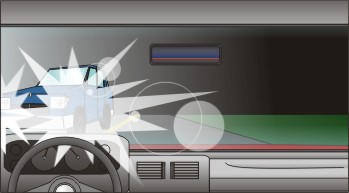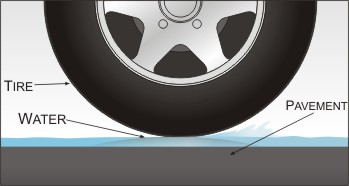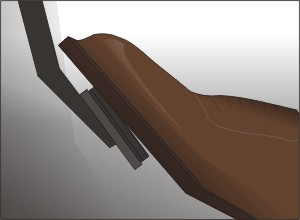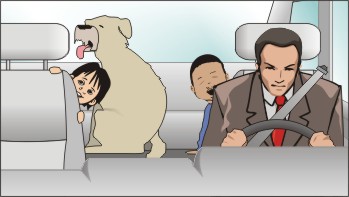Safe driving depends, to a great extent, upon your ability to correctly analyze a traffic situation around you and to react to it. Good seeing habits are most important for responsible driving. However, just being able to see well is no guarantee you will see all critical clues or make correct responses. The driving task is primarily a thinking task. Driving is about 10 percent physical and 90 percent mental. Physically, all you can do is start, stop and turn your car. All the rest is mental. Most responsible drivers use some kind of system that deals with most of the traffic possibilities they will encounter. These drivers have fewer close calls and collisions than drivers who do not use an organized system.
The S.I.P.D.E. process is an organized system of seeing, thinking and responding.
- Search
- Identify
- Predict
- Decide
- Execute
SEARCH
You begin by searching the traffic situation to gather information for your decisions and actions. You need to develop a system of searching for information and clues within and about the driving environment to recognize possible problems ahead, behind and on both sides of your car. Your must process this information properly and then decide how to avoid conflict and you must execute the correct actions.
You need to develop a visual search pattern. A visual search pattern is a process of searching critical areas in a regular sequence. To use a visual search pattern, look for clues in a certain pattern and in a systematic manner.
An example of a visual search for driving straight ahead is:
- Glance ahead.
- Check your rearview mirror.
- Glance ahead again.
- Glance at the side of the roadway or intersection.
- Glance ahead again.
- Check your speedometer and gauge.
- Glance ahead again.
All glances should last only an instant.
Different driving environments and traffic situations present a variety of visual search problems. Mr. Harold Smith introduced a system for safe driving many years ago. The Smith System stresses eye discipline and the idea of space cushion.
- Aim high steering:
To "aim high" means to look far ahead when you drive. We do not look at our feet when we walk, we look ahead. Aiming high allows you to be able to analyze traffic situations. In city traffic, look at least one block ahead. On highways and expressways, look as far ahead as possible, for at least 2-3 seconds. - Keep your eyes moving:
Glancing near and far, right and left, in mirrors as well as the instrument panel. Be sure to look ahead again. - Get the big picture:
Getting the big picture is the mental process of putting together the critical clues that your eyes selected and identified as they scanned. - Make sure others see you:
This rule tells you to communicate with other drivers. You can communicate your presence or intentions with lights, horn, car position, eye contact or body movement. - Leave yourself an out.
Leaving yourself an out means you have identified an escape path in case of a possible conflict. You constantly adjust position to keep space around your vehicle in changing traffic conditions. If you do not have at least one available out, adjust your position until you do have one.
IDENTIFY

If you do not know what you are looking for, knowing how, when, and where to look does little good. Identify specific driving related clues.
Identify parked cars on a street, such as front wheels turned towards the street which could be an indication of a motorist possibly pulling into your lane. Vapor coming from an exhaust pipe or a driver sitting in the car. These clues indicate that a parked car may be ready to enter your path of travel.
The kinds of clues you search for will change in different driving environments. In city driving, search for intersections, pedestrians and other traffic. On open highways, search areas much further ahead. Look for crossroads, slow moving vehicles, and animals. During expressway driving, search the other lanes ahead, behind, and beside you.
Identify other users by searching the traffic scene for other roadway users which might affect your planned path of travel.
Develop the habit of ground identification. Ground viewing is when you make quick glances at the roadway in front of your vehicle.
Always be on the lookout to identify problem drivers. Problem drivers usually give clues by their driving behavior. Some fast drivers may be problem drivers. They may try to pass without enough room or in a no passing zone. They frequently change lanes, trying to get ahead of the normal traffic flow. Distracted or confused drivers may also be problem drivers. Be alert for those who are driving with only one hand on the steering wheel while holding a coffee cup or a telephone in the other hand.
The roadway itself is another important area to watch. Identify intersections, hills and curves early. Be aware ahead of time that the width of your lane may be reduced. Multi-lane roadways often narrow into single lane roadways. Identify signs warning you of this change early enough to position your car in the through lane. Always try to avoid making any unnecessary stops in moving traffic.
Identify changes in the width of lanes, such as standing water, potholes or objects in the roadway that can narrow your lane space. Identify these conditions early so that you have more time to plan a path around them.
Your identification process should keep you looking constantly for roadside hazards such as pedestrians, bicyclists, parked cars and animals. Watch for shopping center entrances, roadside stands, and restaurants.
Identify the roadway surface and conditions each time you begin to drive. Many times, the weather will change while you are driving. Roadway surfaces may be dry when you start out and then become wet and slippery with rain.
Identify traffic controls as early as possible so you are ready to make correct responses.
PREDICT
Once you have identified a possible hazard, predict how this hazard might create a conflict. When you predict, you interpret the information you have identified. You predict where possible points of conflict can occur. You try to foresee what might happen and how it might affect your path.
Analyzing a situation is part of predicting. It is also a basic part of responsible driving. Most of the time you will be faced with more than one possible hazard, so predicting can become a complex problem.
Predicting involves what is happening, what could happen and, if it does happen, how it might affect you. To predict, you must evaluate the situation and make a judgment about the possible consequences. The more complex a situation is, the more difficult it is to identify and predict.
Making a judgment about a traffic situation involves measuring, comparing, and evaluating. As you drive, you judge speed, time, space, distance, traction and visibility. You make judgments about your own driving performance as well as the action and performance of other drivers.
When predicting the actions of others, you do not want to assume that other roadway users will always take the correct action. Instead watch for clues to what they might do. The responsible driver predicts that other drivers and pedestrians will make mistakes.
The most important types of predictions to make concerning the actions of other drivers are: Where will the other driver go? What actions will the other driver take? Is more than one action possible? When will the action be taken? Where might I be when that action happens? Where might our paths cross?
You should also attempt to predict that pedestrians may step out in front of you. By making these predictions, you will be able to slow, or stop in order to avoid a conflict.
Always be prepared to adjust your speed for varying conditions and situations. Different traffic, roadway, and weather conditions can change the amount of time and space needed for slowing down and braking control.
DECIDE
Once you have identified a situation and predicted a possible conflict, you must then decide upon an action to avoid the conflict. There is probably no task more important for a driver than making wise decisions in time to avoid conflict. There may be times when you fail to identify every clue in a situation. Other users will often take actions you did not predict. The decisions you make in these situations become the basic factors for your safe driving. Be prepared to change your plans to avoid a conflict.
Any decision you make will be influenced by your own speed and the speed of other vehicles. Many drivers think that slowing down is the only way to avoid a conflict. It is not. It may also require a quick maneuver.
You can decide to change your position on the roadway or you might change lanes to the left or right. The Smith System guidelines of "leave yourself an out" allow you to change directions when necessary. You will then have an escape path to use in order to avoid conflict. Having an escape path gives you space all around your vehicle.
The decision to communicate with others helps reduce a possible conflict. The Smith System Rule, "make sure others see you," tells others where you are and what you plan to do.
You may use your lights to give signals to other drivers. Use your brake lights to signal the other drivers that you intend to slow or stop. Using your turn signals tells the other drivers that you plan to turn or change lanes. Your emergency flashers convey the message I am in trouble or I cannot move. Remember that four way emergency flashing lights on a moving vehicle is a violation of Florida Law. White back up lights let others know that you are backing up or intend to back up. Look for back up lights on cars in parking lots as a clue for a possible conflict. Parking lights warn other drivers that you are parked along the side of the roadway. Try to develop eye contact with other drivers. You can communicate many messages this way. If there is a possibility of conflict, check to see if the other person is looking at you. While eye contact often helps reduce the risk of conflict it does not guarantee that there will not be conflict.
EXECUTE
Carrying out your decisions in order to avoid conflict is the "execute" step in the S.I.P.D.E. process. This step involves the physical skills used in driving. In most cases you will execute routine maneuvers and actions.
Executing the decision to accelerate means you have judged the speed and use of space by others. You might accelerate to get out of another driver's way or to avoid an obstruction in the roadway. Remember that different vehicles have different acceleration capabilities. Consider your own vehicle's capabilities before executing a decision to accelerate.
When you have decided to decelerate or brake to reduce risk, you should have already considered the surface of the roadway. The amount of braking needed will vary with the speed of your car and the condition of the roadway. When braking suddenly, check vehicles to the rear. Avoid locking the brakes during an emergency stop. Locked brakes make steering impossible, since wheels must be turning to provide traction for steering.
When you decide to steer away from a conflict, execute just the amount of steering needed. Over steering can cause you to lose control of your vehicle, especially at higher speeds. Higher speeds also require more space for your maneuver.
You will often need to execute a combination of actions. Sometimes you might need to accelerate and steer at the same time. In other situations you might need to brake, communicate, and steer at the same time. The precision and timing with which you execute these actions determines whether or not a conflict will occur.1












